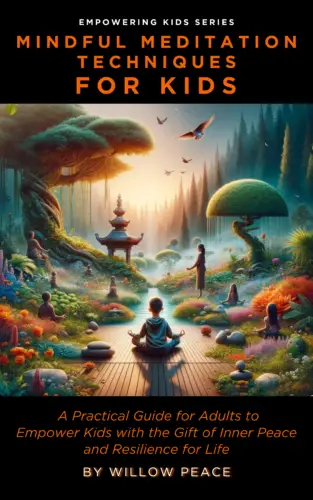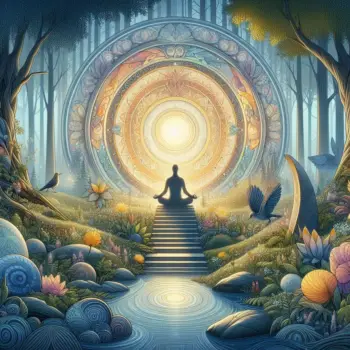By Dakota Flynn
Staff Writer for Wake Up World
Why do countless Spiritual Teachers, Sages, Saints, and Enlightened Beings emphasize the stillness of the mind as the key to self-realization and awakening?
Imagine the mind as a vast ocean, constantly moving with waves of thoughts, emotions, and desires. Throughout the ages, Spiritual Teachers, Sages, Saints, and Enlightened Beings have observed that within this sea of mental activity lies a deeper truth that cannot be grasped through movement or activity. It is within stillness that the surface settles, revealing the clear reflection of what has always been there: our true nature.
These revered figures didn’t point to stillness simply as an antidote to chaos but as the very doorway to awakening. In the absence of mental chatter and the endless stream of desires, we begin to experience life not as fragmented moments but as a unified whole, where the sense of “I” expands beyond personal identity.
Ramana Maharshi, for instance, famously said, “To realize the Self is to be still.” He didn’t mean we must suppress or force the mind to stop; instead, stillness arises naturally when we cease chasing after thoughts and identities, allowing the deeper, unchanging self to emerge.
In stillness, the barriers between “self” and “other” dissolve, and the truth of non-duality—that we are not separate from the world around us—becomes an experiential reality.
“Your innermost sense of self, of who you are, is inseparable from stillness. It is the I Am that is deeper than name and form.”
~ Eckhart Tolle
Defining Stillness
Stillness in Daily Life
Stillness might manifest in everyday experiences as moments of quiet contemplation, a serene walk in nature, or simply a pause between activities. It’s the space where our busy minds settle, allowing us to experience life more deeply and meaningfully.
“Let silence take you to the core of life.”
~ Rumi
Stillness in Meditation
Stillness is often experienced during meditation as a calm and focused mind free from the usual distractions. It’s a crucial aspect of meditation because it helps to quiet the internal noise and facilitates a deeper connection with our true self.
“In the midst of movement and chaos, keep stillness inside of you.”
~ Deepak Chopra
The Role of Stillness in Awakening
Recognizing the True Self
Stillness allows individuals to connect with their true self, beyond the ego and mind. In the quiet, we become more attuned to our inherent nature, which is unchanging and always present.
“Empty yourself of everything. Let the mind rest at peace. The ten thousand things rise and fall while the Self watches their return. They grow and flourish and then return to the source. Returning to the source is stillness, which is the way of the Tao.”
~ Lao Tzu
Stillness as a Pathway to Awareness
Stillness helps recognize the witness or observer within. When the mind is quiet, we can more easily observe our thoughts and emotions without being overwhelmed by them.
“In the stillness of the mind I saw myself as I am: unbound.”
~ Nisargadatta Maharaj
Non-Duality Perspective on Stillness
Oneness and Stillness
Stillness is a natural expression of non-duality and the realization of oneness. When the mind is still, the illusion of separateness fades, revealing the fundamental unity of all things.
“Nothing in all creation is so like God as stillness.”
~ Meister Eckhart
Beyond the Duality of Movement and Stillness
Stillness transcends the concepts of motion and rest, embodying the essence of pure presence. It is not a state to be achieved but the very foundation of our being.
“The secret of the receptive must be sought in stillness.”
~ Zhou Xuanjing
Practical Tips for Cultivating Stillness
Meditation Practices
Engage in regular meditation to cultivate stillness. Techniques such as focusing on the breath, observing thoughts without attachment, or practicing mindfulness can help in experiencing and maintaining stillness.
“Stillness is where the truth lies, beyond the reach of thoughts and desires.”
~ Rupert Spira
Daily Mindfulness
Incorporate mindfulness into your daily life. Simple practices like mindful eating, walking, or even breathing can help bring moments of stillness into everyday activities.
Challenges and Misconceptions
Common Obstacles
Common challenges in experiencing stillness include a restless mind, distractions, and the desire for immediate results. Overcoming these involves patience and consistent practice.
Misconceptions About Stillness
Stillness is often misunderstood as a state of emptiness or inactivity. In reality, it is a state of heightened awareness and presence where we are more deeply connected to our true selves.
“The complete stillness of the brain is an extraordinary thing; it is highly sensitive, vigorous, fully alive, aware of every outward movement but utterly still.”
~ J. Krishnamurti
Krishnamurti’s insight underscores that stillness is not a deadening of the mind but an enhanced state of awareness. It’s a dynamic, alert presence where the mind remains fully engaged yet perfectly calm.
Reflections on Stillness Through Timeless Wisdom
Understanding Stillness through Diverse Perspectives
Stillness, as emphasized by many revered figures throughout history, is not just a state of quiet but a profound gateway to deeper truths. Each perspective offers a unique insight into the essence of stillness and its role in our spiritual journey.
The Divine in Stillness
“It is in the silence of your heart that the Divine will speak to you and will guide you and will lead you to your goal.”
~ Mirra Alfassa, “The Mother”
This quote highlights the idea that stillness is not merely a mental state but a sacred space where divine guidance can be received. The quiet of the heart becomes a listening space where one can connect with a higher purpose and direction.
The How-Less of Stillness
“You know of the how, but I know of the how-less.”
~ Rabia Basri (female Sufi saint)
Rabia Basri’s quote emphasizes the simplicity of stillness. It transcends the need for specific techniques or methods, suggesting that true stillness comes from letting go of the how-to and simply being present.
Stillness as Receptivity
“Stillness is not the absence of movement, but the space in which movement occurs.”
~ Thich Nhat Hanh
This perspective redefines stillness not as inactivity but as the foundation upon which all activities arise. It’s a space of openness and receptivity where movement and stillness coexist harmoniously.
The Boundless Nature of Stillness
“In the depths of stillness, we find the boundless ocean of our true nature.”
~ Gangaji
Gangaji’s quote evokes the image of stillness as a profound depth where our true nature—unlimited and expansive—can be discovered. It suggests that stillness reveals the vast, unbounded aspect of our being.
Embracing Awareness
“True stillness is not the absence of activity but the presence of awareness.”
~ Jon Kabat-Zinn
Jon Kabat-Zinn offers a contemporary understanding of stillness as not merely an absence of activity but the presence of heightened awareness. It’s an active, engaged presence that sees beyond the surface of experience.
The Witness Within
“When the mind is still, you become the observer of your own thoughts, which leads you closer to the truth of who you are.”
~ Sadhguru
Sadhguru’s perspective aligns with the idea that stillness allows us to observe our thoughts from a distance, leading us closer to our true selves. It’s in this detached observation that we uncover our authentic nature.
The Silent Communication
“Stillness is the essence of the mind. It is the profound silence in which the divine speaks.”
~ Eckhart Tolle
Eckhart Tolle reflects on stillness as the fundamental state of the mind where divine communication occurs. We can tune into deeper truths and spiritual insights through this profound silence.
Conclusion
In summary, stillness is not merely the absence of noise but a profound state of awareness and connection with our true nature. Through stillness, we can experience the essence of self-realization and non-duality. By embracing moments of stillness, we can find clarity, peace, and a deeper understanding of who we truly are.
Additional Resources
For those interested in exploring stillness and self-realization further, consider the following book resources:
- The End of Your World by Adyashanti
- The Power of Now by Eckhart Tolle
- I Am That by Nisargadatta Maharaj
- Be As You Are by Ramana Maharshi
- Silence: The Power of Quiet in a World Full of Noise by Thich Nhat Hanh
About the Author
Dakota Flynn is an esoteric writer who blends metaphysical insights with practical guidance. Her writings explore the depths of human experience, inspiring readers to uncover their inner truths and grasp their fundamental nature. By highlighting the interconnectedness of life, she helps individuals achieve an understanding of their existence. Dakota’s work serves as a guiding light for those on a path of spiritual growth, providing valuable tools and wisdom for transformation and self-discovery.
Psilocybin mushrooms, also known as “magic mushrooms,” are reemerging as powerful tools for emotional and spiritual healing. Backed by scientific research, these sacred medicines have shown promise in addressing anxiety, depression, PTSD, and more. However, working with psilocybin requires preparation, intention, and integration to ensure safe and meaningful experiences.
In this 7-week course, a leading herbalist and expert in psilocybin will guide you through every step of the journey. You’ll learn the history, science, and best practices for safe use and how to prepare for your experience, set intentions, and integrate insights into your daily life. Whether you’re curious or ready to take the next step, this course offers the support you need.
Start your journey toward emotional wellness and spiritual growth today. Sign up for this transformative online event and discover how psilocybin mushrooms can help you unlock your fullest potential. Don’t wait — take the first step now!
 If you’ve found value in our articles, we’d greatly appreciate your support by purchasing Mindful Meditation Techniques for Kids—A Practical Guide for Adults to Empower Kids with the Gift of Inner Peace and Resilience for Life.
If you’ve found value in our articles, we’d greatly appreciate your support by purchasing Mindful Meditation Techniques for Kids—A Practical Guide for Adults to Empower Kids with the Gift of Inner Peace and Resilience for Life.
In the spirit of mindfulness, we encourage you to choose the paperback version. Delve into its pages away from screen glare and notifications, allowing yourself to fully immerse in the transformative practices within. The physical book enriches the learning process and serves as a tangible commitment to mindfulness, easily shared among family and friends.
Over the past few years, Wake Up World has faced significant online censorship, impacting our financial ability to stay online. Instead of soliciting donations, we’re exploring win-win solutions with our readers to remain financially viable. Moving into book publishing, we hope to secure ongoing funds to continue our mission. With over 8,500 articles published in the past 13 years, we are committed to keeping our content free and accessible to everyone without resorting to a paywall.









